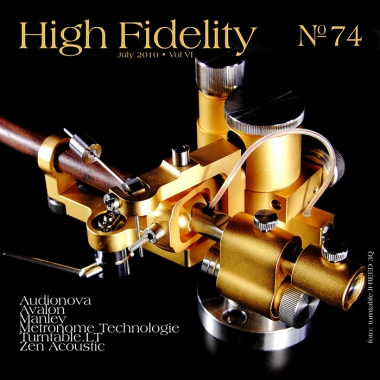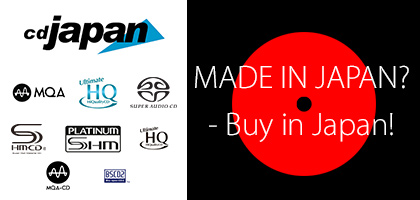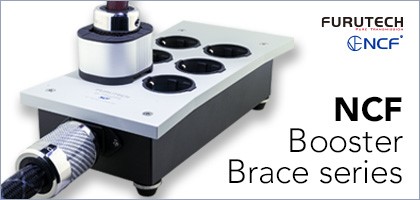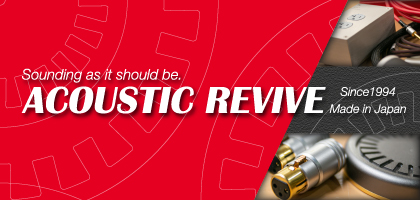 Contents
Contents
No. 248 January 2025
- COVER REVIEW: Gigawatt POWERMASTER 25 ANNIVERSARY EDITION ⸜ AC power conditioner » POLAND
- KRAKOW SONIC SOCIETY № 149: High Fidelity Presents: ART FARMER: Art Farmer in Wrocław » POLAND/Krakow
- REVIEW: Audio Phonique DESIRE SP ⸜ speaker cables » POLAND
- REVIEW: Avatar Audio DREAMLINK № 1 ⸜ analog interconnect • RCA » POLAND
- REVIEW: DS Audio MASTER 3 ⸜ optical cartridge + phono stage » JAPAN
- REVIEW: Laiv HP2A ⸜ preamplifier/headphone amplifier » SINGAPORE
- REVIEW: TiGLON TPL-2000L Professional ⸜ LAN cable » JAPAN


|
MOST IMPORTANT THINGS
The life of an audiophile-music lover, as well as a music lover-audiophile, should be similar to a life of any other “explorer”. Because audio is a challenge. It forces learning a whole life long. The closer we are to the solution of all its mysteries, approaching the “truth” about sound and the reproducing equipment, the more painful is the next step. Because this step is always a step in the void. 
It was not by coincidence, that I included humans in the set of elements responsible for the final result. This is an element, that is most difficult to control, incredibly complex, and still unknown. We know the one and the other, but not for sure, and not completely. Probably everyone can show some turning points in his musical and sonic education, “threshold” experiences, which passes leaving us different, making everything different to that what was before. The first good sound, the first good concert, a revelation during a listening session, pins and needles during a solo, a wonderful immersion in a recording. And some excitation with a device, loudspeakers and similar. And sudden understanding of something or someone. This all combines into a “learning curve”, into what we are at a given timepoint. And the way we understand sound from an audio system has a colossal meaning. Please remind yourself the first meeting with good sound. We did not know, why the sound was good, what is good in it, and even less what is wrong in it. We just felt, that that was it. And we tried to reproduce that at home. And in time, we realized, that this is not the ideal sound, and that things need to be improved in it. After some changes, we could not even point to elements, which made the first sound so appealing to us, because in most cases it was so far away from the ideal. And yet, this imprint from the first true listening session remains in us, and we remember this beautiful feeling. 
We could also create a certain general schematic of such a learning curve. The first meetings with audio are beautiful, because they are absolutely uncontaminated. The knowledge about gear is second to none, about reproduced sound too. Usually we think, that we embraced God. And it is beautiful – that is beautiful. In the sound we search for some elements that constitute it – bass, treble, maybe some space. This will change, when we will be exposed to the branch press for long enough, “infected” colleagues and friends, audio shows and similar. This changes a person forever, robbing him from the initial innocence. But it is inevitable. I always try to underline, wherever it is possible, that I do not believe in a “carte blanche”, which a music listener, audiophile or reviewer, should be. This is rubbish, nonsense, and the main methodology error. There is nothing like a carte blanche. Nature does not tolerate void, and it is exactly the case here – we are full of judgments, associations, statements, experiences, speculations, etc, so we need to clean things up, or change this to something new, something we have learned. 
This is the reason why reading audio magazines is a must in the case of an audiophile – music lover. It is best to read as much as possible, as many titles as possible. Printed ones and those published in the internet. In the last case it is possible, that we encounter amateurs, or opinions bought by manufacturers, etc. The editor in chief of “Stereophile”, John Atkinson, pointed this out in his last editorial, noting, that according to Sturgeon’s law (a sci-fi author) 90% of what is spoken is rubbish (J. Atkinson, iPad Daze, Stereophile”, June 2010, Vol.33, No.6, p. 3). By telling, that only printed magazines are trustworthy, while the internet is an area ruled by hellish forces, he forgot, that this law is true for all human activity, and there is no difference between the internet and printed materials. Yes, because the net has much more information, much more of its contents is crap. But we deal with the same thing with printed press. It is interesting, but lately the printed magazines try to tell the readers, that it is only them telling the truth, that only they have the patent for it. At the same time with the Stereophile’s editorial, almost the same thing was said by the editor in chief of „The Abso!ute Sound” (R. Harley, Have Your Cake and Eat it, Too, „The Abso!ute Sound”, June/July 2010, Issue 203, p. 12). Is it because they feel our breath on their necks? I am not sure. But I do know one thing for sure – such self-inflation does not lead to anything good, because we lose sight of the bigger whole. But returning to the main topic – we need to learn all the time. After the first contact with audio, in time we reach a point, where we can fairly describe what we hear, we use technical terms (it is called jargon), we know the brands, names, etc. We probably also have a fair system and a rich collection of discs. At this point in time, we care about a sound, that is resolved, has a good, colorful and differentiated bas and a vivid, “honey”, precise treble, and a saturated, full midrange. And about a precise, holographic sound stage. And that is right – 99% of the tests in audio magazines relate to this point, and this is something we can discuss. Please look at any of the tests in “High Fidelity” and you will know, what I am talking about. And this is good, I say. But at some point a change of perspective occurs. When we know everything, when we have everything I am talking about in the sound, we lose our interest in it. Exactly that – it loses its meaning. Because sound should awaken emotions. It has to take possession of us, we should get “connected” to the event on the disc. Music is to move us. It has to create goose-flesh. It has to exclude us from the outside world. Is this what we meant earlier? Is this what we are writing about? NO!!! Earlier it was about the smallest things, elements of the sound, while being in the place I am talking about now, those details do not exist, there is nothing like bass and treble. There is a larger whole, which works or does not work – either we are submerged in music or not. To make it clear: this is the return to the “first listening session”, to a certain state of innocence. Not a regress, but a return – the return of a wiser man, a man rich in experience. I do not like to use this word, as it was overused and it lost most of its operational and cognitive meaning (the more, as the postmodernism related to it also seems to be dying), but this is a bit like with deconstruction: first we split the specimen (in this case the sound) in to primary items, we look at them, we comment their interdependencies, and then we combine it back together. Even if it will not look the same as in the very beginning, WE, the observers, will be different. We will have experience. We will have knowledge. And this is how it goes with audio. |

On the stage I am talking about, the sound of the system (because it is about the growth of awareness and system) may not be bright or analytic – and the Japanese knew it all along. Earlier on the path we can find devices that fulfill this postulate, but too “hi” to be close to the “end”. Only at some point, the assets of “hi-fi” combine with what I am saying into an ideal, complete entity. There has to be a base to it. And this sound is rather warm, and rather dark. Compared to the systems, we thought earlier they are superb, it is much deeper. There is no tendency to describe the sound stage, placing of the instruments, because everything is so natural, that we can thing about the acoustics of the recording room, and not about the sound stage. We just go to the recording place, and we are there. I repeat: the base for it is everything I said, but this is only a beginning, a starting point. But how to describe that? Now here is the problem, and this is a completely different story. It is however important, to remember one thing: the endpoint is very similar to the starting point. But between them, there is a path, which has to be followed, and work that has to be done. But the reward is immense. 
V-CAPPED A part of the growing process is related to exchanging devices for better ones. For those that play in a system. This needs to be a system, and not a set. Changes happen also at my home. I am writing about that, to keep you updated on the latest changes, as this system is my reference. One of the newest items is the Lektor Air Ancient Audio. I wrote about it earlier, but I finally brought home the finished version. The most important change was the addition of new, beautiful and shockingly expensive, copper-Teflon capacitors from the American company V-Cap CuTF. This is the best thing, that was manufactured by Chris VenHaus, the owner of the company. They are still burning in, but I can hear already, that the treble is pure brilliant, and the sound is going in the direction I described earlier. Encouraged by this success I changed also the coupling capacitors in my version of the Leben CS-300XS Custom Version. And it is also beautiful. Mr. Waszczyszyn, who exchanged the capacitors, told me, that my version has resistors in the power supply instead of the choke. This is interesting, because one of the differences of the basic and XS version of the Leben is that choke. But seemingly the owner of Leben thinks exactly like Mr. Waszczyszyn, that a choke is only a partial resolution to the problem, and when we are searching for something extraordinary, we can fare better without it. And because this amplifier was built as a custom unit for me, he could do whatever he found sounding best. However the side effect of the lack of the choke was the increased noise, especially annoying when using headphones, my Sennheiser HD800, which have an impedance of 300Ω. But we employed additional resistors on the headphone output, and now everything is OK. 
But my being V-Capped reaches further – I ordered, and they also arrived, capacitors for my preamplifier Ayon Polaris II – Teflon and oil type. I did not solder them yet, but I know, it will be OK, because I know the capacitors from Ancient Audio products, and they never let down on me. As a final note, I will only say, that Chris treats his clients with due esteem, and one of the visible care items was the way the capacitors were packaged, the four pieces for my Polaris came fantastically packed, in a big box with foam chips. This is how it should be done by every company. PLANSLike I said many times before, plans are the most daring part of my magazine’s doings, because they almost never work out. That was the case with the test of the Harbeth Model 40.1, which was planned in this issue of “High Fidelity” – unfortunately the dedicated stands did not arrive, and the distributor decided, we should reschedule the test. Nevertheless I would like to show you some tests, that are almost certain to happen, and their results will be published in the July and August issues. On a side note – it seems, that HF will be the only Polish language audio magazine, that will have a July and August issue, while other will have a combined, summer one. JULY 2010
AUGUST 2010

Finally, I would like to draw your attention to a new company: franc audio accessoriess (f-franc@wp.pl). I just received for testing (I am preparing a test of anti-vibration feet for “Audio”) anti-vibration feet from that company. Already the packaging makes an incredible impression, and this impression is confirmed with that, what we find inside. They are beautifully crafted, and there is a reasonable idea behind it. I do not know yet, what is their influence on the sound, but I am already very positive! And finally, I renew my request to You, the Readers: “High Fidelity” is a free magazine for you, but someone has to pay for it – this someone are the distributors, the manufacturers, audio salons, who buy banners in our magazine. So I ask you, to visit them by clicking on the banners, to explore their web pages, etc. Wojciech Pacuła |
About Us |
We cooperate |
Patrons |
|
Our reviewers regularly contribute to “Enjoy the Music.com”, “Positive-Feedback.com”, “HiFiStatement.net” and “Hi-Fi Choice & Home Cinema. Edycja Polska” . "High Fidelity" is a monthly magazine dedicated to high quality sound. It has been published since May 1st, 2004. Up until October 2008, the magazine was called "High Fidelity OnLine", but since November 2008 it has been registered under the new title. "High Fidelity" is an online magazine, i.e. it is only published on the web. For the last few years it has been published both in Polish and in English. Thanks to our English section, the magazine has now a worldwide reach - statistics show that we have readers from almost every country in the world. Once a year, we prepare a printed edition of one of reviews published online. This unique, limited collector's edition is given to the visitors of the Audio Show in Warsaw, Poland, held in November of each year. For years, "High Fidelity" has been cooperating with other audio magazines, including “Enjoy the Music.com” and “Positive-Feedback.com” in the U.S. and “HiFiStatement.net” in Germany. Our reviews have also been published by “6moons.com”. You can contact any of our contributors by clicking his email address on our CONTACT page. |
 



|
   |
main page | archive | contact | kts
© 2009 HighFidelity, design by PikselStudio,
projektowanie stron www: Indecity










